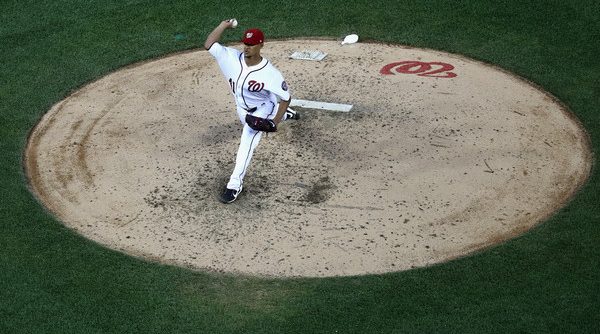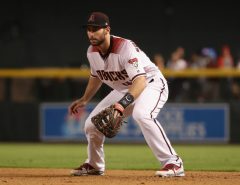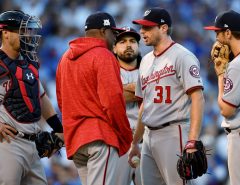Last Tuesday I discussed the state of the Nationals offensive depth, and what it could mean for the rest of the season. While I said I would write a follow up discussing the pitchers in a couple days, work and life got in the way (as they do) and I’m getting this to you a little late, so I apologize for that. Without further ado, let’s take a closer look at the Nationals pitching depth.
Despite the struggles of the bullpen, the pitching staff (well mostly the rotation) has been a large part of the reason the Nationals have gotten off to such an amazing start. With the exception of the fifth starter spot, the rotation has been excellent; Gio Gonzalez has rebounded from a rough 2016 in a big way, Tanner Roark has had his ups and downs but has mostly been solid, and Stephen Strasburg and Max Scherzer both appear to be in in the early running for the Cy Young. In AAA however, things haven’t been quite as rosy. The Chiefs currently sit in dead last place in the International League thanks in large part to a 5.51 team ERA. The 5 pitchers with the most starts for Syracuse (Austin Voth, AJ Cole, Kyle McGowin, Greg Ross, and Taylor Hill) sport ERA’s of 6.00, 5.32, 5.98, 6.38, and 9.29 respectively. Those are some early 2000’s Orioles numbers; this obviously doesn’t bode well for the Nationals pitching depth.
As it stands right now, the fifth starter is Joe Ross, who is something of an X-factor for this Nationals team. It’s been a strange season for Ross, who was expected to be locked into the rotation following a stellar 2016. Demoted to Syracuse right out of the gate in order to make room for an extra bench piece, Ross found himself temporarily replaced by Jeremy Guthrie as the fifth starter due to roster technicalities, and didn’t receive his first call up until April 19th. Ross was once again demoted in early May, but was recalled for a second time when Jacob Turner was converted to the bullpen. Since his second call-up, Ross has been unable to find any kind of consistency; one day he looks like Scherzer on the mound and the next day he’ll look like the second coming of Shairon Martis. Joe Ross will never be Max Scherzer, and he’s certainly not Shairon Martis, but the Nationals will need him to find some level of consistent success down the stretch if they want to continue their early season dominance.
I tend to believe that Ross isn’t as bad as he’s looked so far, as he’s suffered a fair bit of bad luck. His BABIP currently stands at an inflated .355, while his HR/FB% currently sits at a crisp 20.5%. To put that into context in the FanGraphs Library article explaining, HR/FB% they have a chart showing how different rates stack up that lists 13.0% as “awful” — their worst possible category, so that number is likely to come down. It’s not only batted ball statistics that back up Ross’ better-than-he-actually-looks-
With all that said, Ross is still a member of the rotation, so while his performance will have a large impact on the rotational depth going forward, he doesn’t actually factor into that depth. However as I mentioned earlier the depth options past him have been less than inspiring. Turner has been the most used spot starter thus far, but it seems the Nationals prefer him in a relief role, and even then his stock has been declining steadily since early May. Arguably the Nationals number one depth starter at the moment is Cole, who is currently the proud owner of a 5.68 ERA at Triple-A Syracuse. Cole has been the captain of the Nationals shuttle bus team for the last couple of seasons, and was looking primed to finally break out this year. However things have not gone according to plan as Cole has seen his peripherals decline across the board. Cole is walking more batters, striking out fewer batters, and allowing more hits; the only thing Cole is doing well at the moment is inducing groundballs (and in turn allowing fewer flyballs and home runs). In his one start so far this season for the big club, Cole allowed only one run, but struck out only two batters and was generally hit hard all around the diamond. Cole may be suffering a bit of bad luck, his BABIP is high (.347) and his strand rate is low (7% lower than his career average), but he has still clearly taken a step back this season.
Cole’s fellow top prospect, soft-tossing right hander Austin Voth, has been even worse this season for the Chiefs. Like Cole, Voth’s peripherals are down across the board. In his eye opening 2016 Voth sported a K/9 of 7.62 and BB/9 of 3.27, not great numbers, but good enough when you induce the type of soft contact that Voth does. However in 2017 not only has Voth been unable to put away batters at the same clip (6.02 and 4.70 K/9 and BB/9 respectively), but he has also been getting hit extremely hard. Whether this is due to Triple-A hitters adjusting to Voth, a minor injury, or a mechanical issue I can’t say, but it’s clear Voth has effectively written himself out of the depth chart following a stellar 2016. Other options in Syracuse include McGowin, Greg Ross, and the recently signed Sean O’Sullivan and Edwin Jackson. Out of those, three the only real viable major league option would be the veteran O’Sullivan, who has at least shown an ability to get pitch at the major league level. In three MLB appearances this season, Jackson has a 7.20 ERA. The results have been bad across the board for O’Sullivan, but McGowin and Ross have yet to show they’re even capable of pitching at the AAA level, so they would only be absolute emergency options for spot starts. In fact, McGowin was demoted to Double-A Harrisburg, getting replaced by Jaron Long.
When considering depth, the bullpen is in a very different position from the rotation. While the Nationals rotation depth is relatively thin, it appears so thin because of the great disparity between what you could expect to receive from say, Max Scherzer, compared to any of the Nationals current depth options. With the bullpen, the major league performance has been so subpar that despite the limited amount of impact arms at AAA, the depth remains intact. This Syracuse pitching staff isn’t flush with talent, but the Nationals’ bullpen has been so astoundingly bad that the Nationals could call up many of their AAA arms and receive a similarly poor result.
That isn’t to say there’s no talented arms in Syracuse mind you. Austin Adams is a pitcher I’ve talked about several times in the past, and despite severe drawbacks/red flags has arguably the best raw stuff of any reliever in the Nats farm system. His total lack of control limits his potential impact at the major league level, but in terms of talent alone he’s at least near the top of the Nationals farm system. Joining Adams on the 40-man are recently promoted “veteran” righty Trevor Gott and southpaw Matt Grace, who has been on the Syracuse shuttle all season. Gott isn’t going to magically transform the bullpen into a successful unit, but has been excellent at Syracuse and has a (small) track record of major league success, so should at least be able to provide a steady presence in the bullpen. Grace, on the other hand, has already made a few mediocre appearances for the Nats, but with Oliver Perez and Enny Romero trending upwards, finds himself on the outside looking in. Jimmy Cordero remains on the 40-man roster, but he will need to put his early season struggles fully behind him in order to factor into the bullpen situation, even as a September call up. Beyond the 40-man roster there are intriguing arms such as Wander Suero, Ryan Brinley, and veteran Neal Cotts, but all of these guys will need to take a step forward if they hope to contribute to the big club.
While the Nationals bullpen depth chart is mostly unexciting, there is one pitcher who has the talent to transform the Nationals bullpen: top pitching prospect Erick Fedde. After transitioning to the Harrisburg bullpen, Fedde pitched 13.2 innings with 11 hits, 4 walks, and 19 strikeouts, good for a 2.63 ERA and a promotion to Syracuse. Fedde gave up a run in each of his first two Triple-A outings, but the native Las Vegan (?) is still adjusting to life in the bullpen and showed an ability to adjust in Harrisburg. Fedde has raw stuff unmatched by any pitcher in the farm system, and it look like it should be even more deadly out of the pen. Perhaps the greatest asset in Fedde’s arsenal is his ability to pitch multiple innings. Over the last few seasons the MLB has seen the value of elite relievers who can pitch multiple innings skyrocket. Highlighted by Andrew Miller’s playoff performance and the emergence of Chris Devenski, this phenomenon has made teams such as the Nationals take a second look at their pitching prospects in the pursuit of high value elite bullpen arms. Zach Spedden broke down Fedde’s transition in much more depth on Thursday, but it’s clear that Erick Fedde is an x-factor for the Nationals looming in the minor leagues.
The great thing about discussing depth is that literally none of this could matter. The rotation could stay healthy and the bullpen could somehow magically fix itself tomorrow, but in baseball the safest bet is to always expecting things to go horribly wrong. For me, the lack of a true sixth starter is the most concerning element of the Nationals depth chart going forward. AJ Cole should be fine in spot starts, but should the Nationals need to call upon him for any significant amount of time the club might be forced into an uncomfortable position either at the deadline or even later in the season. What the Nationals could do to fix this problem is for another article another time, but it might take some front office creativity or plain old luck. Going forward the bullpen isn’t a concern (at least depth wise) because there’s quite literally no place to go but up. The unit is currently missing both Koda Glover and Sammy Solis, and the potential emergence of Fedde goes a long way to soothing my concerns about the bullpen running into any future depth issues, though I still lose sleep over all of the bullpen’s other issues.
Tags: AJ Cole, Austin Adams, Austin Voth, Edwin Jackson, Erick Fedde, Greg Ross, Jimmy Cordero, Kyle McGowin, Matt Grace, Nationals, Nats, Neal Cotts, Ryan Brinley, Taylor Hill, Trevor Gott, Wander Suero, Washington Nationals




Thanks for the info. But this is a suggestion: try to avoid using the personal pronoun “I” in your writings.
Here’s the thing about the pitching depth problem — in a competitive division, it would matter. But the Nats could roll my mom out there every 5th day and still win the division handily. And then they’ll only need 3 starters in October. So if it were my team, I’d start Joe Ross every 5th day, and on the frequent days when he does poorly, you have Turner try to bridge the gap to the 7th inning. Later in the season, we’ll have Fedde, and you can shorten up Ross’ outings so that he’s just a fireballing reliever. A bullpen of Gio, Fedde, Ross, Glover, and a couple LOOGYs should be pretty capable.
You need 4 starters not 3 in the playoffs and Gio is ahead of Roark at this point..We need a capable closer and the we can get by with the rest of the hambones we have.
I am a loyal fan but the bullpen is a joke. Nothing has been done to correct this problem. Unless drastic changes are made quickly it will be useless to get to the playoffs
It’s high time Joe Ross be assigned the closer role. What more will it take? Perhaps a collapse like the 1964 Phillies will open up those heavy lids full of sand.
Nationals management is failing badly with no need. Ross could be a prime dloser. He is certainly NOT a prime starter. What do you have to lose but the pennant?!!!